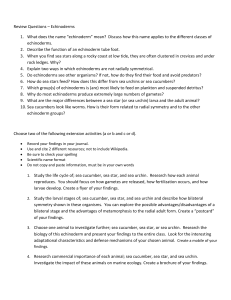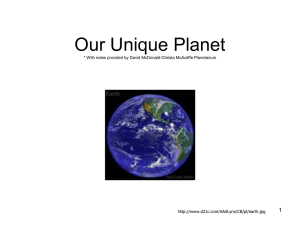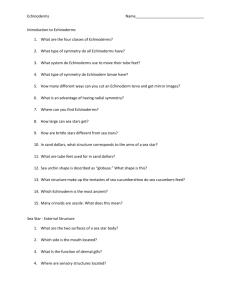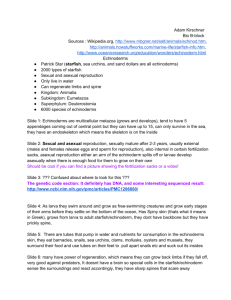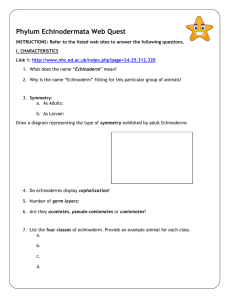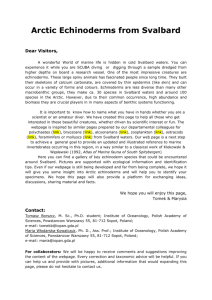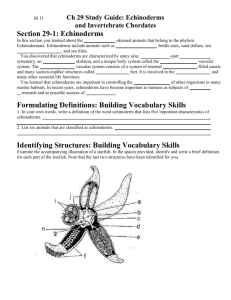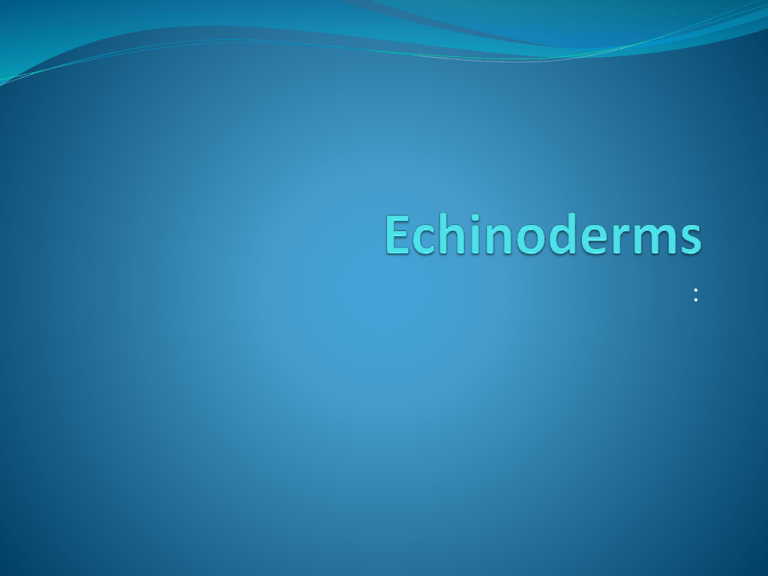
:
Echinoderms
Spiny-skinned
Sea Star (Starfish)
Green Sea Urchin
Rosy Feather Star
Echinoderms are animals with no: brain, eyes, heart,
or lungs
Water-vascular system
Taxonomy
Common starfish
Asterias rubens
Green sea urchin
Psammechinus miliaris
Rosy feather-star
Antedon bifida
Kingdom
Animalia
Animalia
Animalia
Phylum
Echinodermata
Echinodermata
Echinodermata
Class
Asteroidea
Echinoidea
Crinoidea
Order
Forcipulatida
Echinoida
Comatulida
Family
Asteriidae
Paechinidae
Antedonidae
Genus
Asterias
Psammechinus
Antedon
Species
Rubens
Miliaris
Bifida
Habitat
Deep sea
Brackish water
Half fresh and half salt water
Substratum
Non-living material where a living organism lives or
grows
Role in the Ecosystem
Skin gills
Oxygen in Carbon Dioxide out
Eaters
Carnivorous- meat eater
Omnivorous-both meat and plant eater
Bilateral Symmetry
Radial Symmetry
Pentamerous
Symmetry (Sea stars
and Brittle stars)not immediately
obvious at first, but
later notice.
Integumentary System
Spiny-skinned
Skin-gills
Spines
Pedicelarias
Skeletal system
Calcareous spines
Endoskeleton
Calcareous plates
Locomotion
Sea Stars and Sea Urchins
Water Vasculatory system
Sieve pate (Madreporite)
Stone Canal (Careous ring)
Ring Canals
Radial Canals
Ampulla
Tube feet
Unison
Feather Stars
Circulatory system
Water
vasculatory
system
Coelom
Cilia
Gaseous
exchange
.
Respiratory System
Skin gills
Between calcareous plates
Ingress and egress
Oxygen
Carbon Dioxide
Diffusion
coelomic fluid
carbon dioxide
Digestive & Excretory system
Excretion
Coelomic fluid
Ameboid cells
Nitrogenous wastes
Skin gills
Nervous system
Ring of nervous tissue:
Nerve net
Sense organs
Pigmented eyespot
Responds to touch
Reproductive system
Sex Organs
Gonad
Gonopore
Spawn
Ovaries
Testes
Spawn in the sea
Endocrine system
Water Vasculatory System
Stone Canal
Radial Canal
Life Cycle
Spawn
Fertilization
Physicochemical
changes
Blastula
Gastrula
Ectoderm
Inner endoderm
Coelom
(Continued)
Anterior coelomic sac sends a tubular outgrowth
Cilia lines this tube
Larva is bipinnaria-has bilaterally symmetrical lobes
bearing ciliated bands
Human Interaction
There are some Edible Sea Urchins
Edible Parts
Ripe Eggs
Coiled Intestine
An opportunity to document the taphonomic process
of Cambrian stalked echinoderms in more detail
Studies on Echinoderms provides evidence of volatile
organs within gogiids.
Interview
1. Which animal do you most enjoy studying? Why?
Assuming you are asking me about echinoderms, I would say I have
often enjoyed observing sea stars. In 1996-1998 I worked as a
naturalist at Marine World’s aquarium and tide pool
exhibit. (Marine World is now 6 Flags.) During an eight hour shift,
which was spent answering questions about various species’ natural
history, I had the opportunity to observe sea star mobility. They
would be in one location in the wee hours of the morning and be on
the other side of the tide pool by the time I left in the late afternoon.
I liked watching their delicate tube feet extend and waver. I admire
the strength and dexterity of the starfish as it gloms onto a mussel
and pries it apart with a surprising viselike grip. What
determination!
(Continued)
2. Which species of Echinoderms do you find most
interesting? Why?
I adore the diversity between sea star specimens. For
example, take the rough texture and squatty shape of a
bat star versus the silky smoothness and elegant lines
of a leather star. The amazing variety of rainbow hues
on the sea stars is fascinating…purple, orange, blue
spots, mud-colored, the list goes on and on. I also
think it is totally unique that they can regenerate an
arm, should one be “lost”.
(Continued)
3. Fossil records helped to make Echinoderms become a
well-defined and highly derived clad of metazoans. Why,
exactly is this extensive amount of fossils significant?
The five fold symmetry of a sea star or sea urchin is
easily recognizable. Thus, when calcite skeletons are
found in strata of limestone, it is easy to determine the
echinoderm clad. Therefore, the numerous fossil
echinoderms help scientists to see patterns of
evolution.
(Continued)
4. Why are there so many fossils of Echinoderms?
The calcite parts are pretty tough and unless the fossil
hunter bangs it with a hammer it will survive well as a
fossil. However, after an echinoderm’s demise, its body
parts can crumble apart as the musculature
disintegrates. Therefore, the best looking fossils are from
when the specimen was buried in strata immediately upon
death. Complete fossils are rarely found, but as they say
“seek and ye shall find”, and the scientists keep searching.
Bibliography
http://universe-review.ca/I10-82-starfish.jpg
http://www.infovisual.info/02/011_en.html
http://universe-review.ca/I10-82-starfish2.jpg
http://animaldiversity.ummz.umich.edu/site/resources/biodidac/crin0
04_009.gif/medium.jpg
http://animaldiversity.ummz.umich.edu/site/resources/Grzimek_inver
ts/Crinoidea/v01_id240_con_crianat.jpg/medium.jpg
http://www.cals.ncsu.edu/course/zo150/mozley/fall/seaurchinanat.jpg
http://www.geo.lsa.umich.edu/~kacey/ugrad/3-pht--echB.GIF
http://library.thinkquest.org/26153/marine/sketch/791b.jpg
http://library.thinkquest.org/26153/marine/sketch/791a.jpg
http://biology.unm.edu/ccouncil/Biology_203/Images/SimpleAnimals/
cnidariaDiagram.jpeg
http://universe-review.ca/I10-82-starfish2.jpg
http://www.daviddarling.info/images/starfish_disk_and_arm.jpg
(Continued)
http://www.personal.kent.edu/~alisonjs/paleo/morph.gif
http://www.mesa.edu.au/friends/seashores/images/Urchin
.jpg
http://higheredbcs.wiley.com/legacy/college/levin/0471697
435/chap_tut/images/nw0262-nn.jpg
http://jwilson.coe.uga.edu/EMT668/EMAT6680.2002.Fall/
Nazarewicz/7210_final_2/7210_Project/pictures/image3.gif
http://www.seaotter.com/marine/research/stronglyocentro
tus/droebachiensis/pics/droebachiensis.jpg
http://www.sms.si.edu/IRLFieldGuide/images/Urchin.gif




